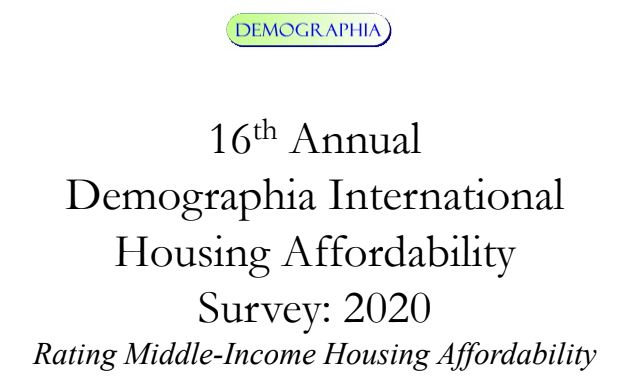One of the principal advances of the past two centuries has been the drastic reduction in poverty and the rise of a large middle-class, a process expertly detailed by economists Diedre McClosky and Robert Gordon. At the heart of this trend was the increase in the home...
Wendell Cox
16th Annual Demographia International Housing Affordability Survey
How affordable is housing in your City? There has long been concern about deteriorating housing affordability in Canada. The OECD has expressed concerns about the decline of the middle-class in Canada and the substantial role of house price increases. Two of the 10...
High-Speed Rail: Stop, Look, and Listen
To listen to the promoters, the Vancouver to Seattle and Portland high-speed rail proposal may look like a great idea. For many, high-speed rail is a panacea that promises to solve all of our transportation and environmental problems. It behooves governments and...
Why Ottawa’s Attempts to Help Young Canadians Afford Housing Simply Won’t Work
The federal Liberal government’s proposed budget includes an innovative plan to improve housing affordability through “shared equity” mortgages. First-time homebuyers could qualify for a 10-per-cent “shared equity” mortgage on Canadian Mortgage and Housing...
Featured News
Leon Fontaine – A Passionate Canadian Thought Leader – RIP
This past weekend, we learned of the tragic and unexpected passing of Pastor Leon Fontaine at 59 years of age. Leon was a gifted leader playing many roles both nationally and internationally. He was, with his wife Sally, the senior Pastors at Springs Church with...
Public Inquiries and Public Trust
Testimony before the Public Order Emergency Commission reveals the case for government invoking the Emergencies Act is either weak or very weak. The Prime Minister was, in fact, opposed to members of his cabinet or senior public health officials meeting with protest...
Toward a Self Employed Nation?
The United States labor market has been undergoing a substantial shift toward small-scale entrepreneurship. The number of proprietors – owners of businesses who are not wage and salary employees, has skyrocketed, especially in the last decade. Proprietors are self employed business owners who use Internal Revenue Service Schedule C to file their federal income tax. Wage and salary workers are all employees of any establishment (private or government), from executives to non-supervisory workers.
Poverty and Growth: Retro-Urbanists Cling to the Myth of Suburban Decline: Suburbs have more poor people mainly because they have more people, write Joel Kotkin and Wendell Cox.
In the wake of the post-2008 housing bust, suburbia has become associated with many of the same ills long associated with cities, as our urban-based press corps and cultural elite cheerfully sneer at each new sign of decline, most recently a study released Monday by the Brookings Institution—which has become something of a Vatican for anti-suburban theology—trumpeting the news that there are now 1 million more poor people in America’s suburbs than in its cities.
Toward More Prosperous Cities: Cities should fight poverty, not increase it
Beyond the rule of law and security, the most important public policy objectives should be to achieve wide-spread affluence and eradicate poverty. Cities, urban policy, and urban transport are means to facilitate this objective, not ends themselves.
Sydney to Abandon Radical Urban Containment Policy
The New South Wales government has proposed a new Metropolitan Strategy for the Sydney area which would significantly weaken the urban containment policy (also called urban consolidation, smart growth, livability, growth management, densification, etc.) that has driven if house prices to among the highest in the affluent New World (Australia, Canada, New Zealand and the United States) relative to household incomes.
9th Annual Demographia International Housing Affordability Survey
EXECUTIVE SUMMARY Download the Full Report as a PDF here Rating Housing Affordability The 9th Annual Demographia International Housing Affordability Survey covers 337 metropolitan markets in Australia, Canada, Hong Kong, Ireland, New Zealand, the United Kingdom and...
What is a Half-Urban World?
Within the last couple of years, the population of the world has become more than one half urban for the first time in history. By 2025, the world’s urban areas are expected to account for 58% of the world population, rising further to two-thirds in 2050. This represents a huge increase from the 29% that was urban in 1950, or estimates of approximately 10% (or less) in 1800.
A Planet of People: Angel’s Planet of Cities
Planet of Cities looks at the urbanization trend from various dimensions. A sample of 30 urban areas was used to gauge urban expansion and density changes from 1800 to 2000.
Mortgage Rules Won’t Lower Prices: Land restrictions drive housing prices
The newly announced mortgage rules by the federal government will do little to advance housing affordability in Canada.
Improving the Competitiveness of Metropolitan Areas
Centrally-determined national transportation policies are misguided and wasteful. They do not solve the choking traffic problems that plague large urban centers but often make matters worse, undermining the competitiveness of metropolitan areas.



